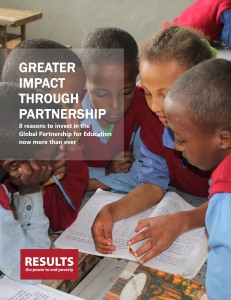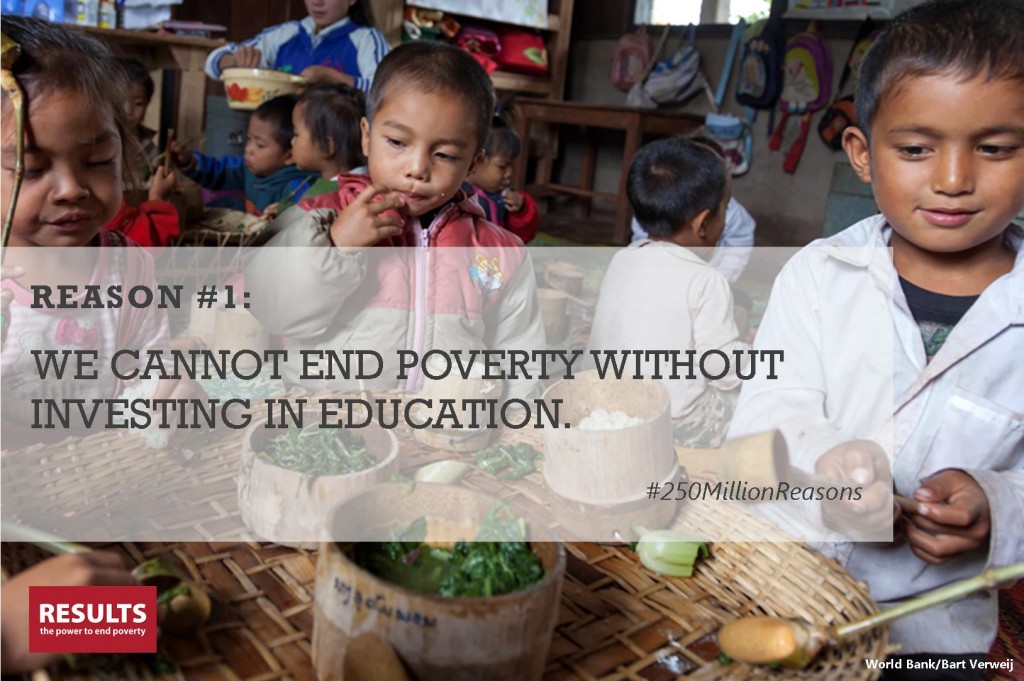Earlier this week, the Global Partnership for Education (GPE) launched its full ‘case for investment’ for its replenishment taking place this year. Called ‘250 million reasons to invest in education’, the report announces that with a successful replenishment, the Global Partnership could support 29 million more children to receive a good quality basic education, 23 million of them in fragile, conflict-affected countries.
Right on the heels of GPE’s own announcement, we are excited to be launching today a new RESULTS report ‘Greater impact through partnership: 8 reasons to invest in the Global Partnership for Education now more than ever’. This joint report, released simultaneously by RESULTS affiliates in Australia, Canada, the UK and United States, highlights that the Global Partnership for Education’s replenishment conference in June this year could be a vital turning point in achieving education for all children – But only if world leaders make ambitious financial commitments.
Worldwide, 57 million children remain out of primary school, and nearly 40 percent of the world’s primary school-aged children still don’t know how to read, write, or count. UNESCO reported this year that despite progress made in enrolling millions of children into school, there remains an urgent “global learning crisis” that must be addressed if the Millennium Development Goals, and ambitious Post-2015 development goals, are to be reached.
If donor governments like the UK, US, Canada and Australia meet the GPE’s financing target of $3.5 billion, the Global Partnership will support education for 29 million of the poorest and most vulnerable children in primary and secondary school, and increase the number of children completing primary school with literacy and numeracy skills by 25 percent in 66 developing country partners by 2018.
And even more impressively, donor contributions of $3.5 billion to the Global Partnership have the power to leverage an additional $16 billion in domestic financing from the GPE’s developing country partners – going a long way towards filling the global financing gap for education and demonstrating that developing countries are stepping up to take ownership of their own education systems.
But we can’t do it without ambitious investments from donors. As the report details, here in the UK RESULTS is advocating for an early and ambitious four-year pledge from the UK Government of up to £525 million to the GPE fund. The UK is the current largest donor to the GPE, as well as a leading bilateral donor to education. That leadership is vital, and must be maintained. We are urging the UK to commit to provide 25 percent of the total contributions to the GPE target if other donors also step up to join them in ensuring the Global Partnership reaches its US$3.5 billion target this year. We want them to also maintain their own levels of bilateral aid to education, which is changing millions of lives in the poorest countries.
There is clear and powerful alignment between what the UK’s Department for International Development is trying to achieve, and the objectives of GPE, especially in terms of focusing on the most marginalised children – those in conflict countries, girls, and children with disabilities. We hope to see UK Ministers working to galvanise other donor countries to be ambitious at this critical moment, to ensure that every child worldwide can achieve their right to a quality education.
Our new report makes clear the powerful reasons why investing in the Global Partnership for Education is the right and smart thing for the UK, US, Canada and Australia to do. We hope it also provides the strong arguments needed by our grassroots advocates, partners, Parliamentarians and the media about not only the importance of education but the opportunity the Global Partnership for Education’s June pledging conference provides to make a difference in the lives and futures of the poorest and most vulnerable children around the world.
You can download the full report here, and catch a glimpse of our ‘8 reasons’ below.
Over the next eight weeks, RESULTS affiliates in Australia, Canada, the US, and here in the UK will delve deeper into each of the eight reasons through a series of blog posts. Each piece will be cross-posted on our blog, so check back each week for the latest.
We encourage you to also Tweet about this – pick your favourite reason from below!
8 reasons to invest in the Global Partnership for Education now more than ever:
1. We cannot end poverty without investing in education. Education is intrinsically related to our other efforts to reduce poverty.
2. The Global Partnership for Education reaches those in the greatest need – especially those in fragile contexts and humanitarian emergencies. Nearly three-quarters of the world’s 57 million primary school-aged children who are out of school live in GPE developing country partners.
3. The Global Partnership for Education complements bilateral efforts in global education. Support for the Global Partnership helps donors reach their own development objectives, including the goals of UK bilateral education and development programs.
4. The Global Partnership for Education mobilizes developing country resources towards their own education systems. Developing countries that are part of the Global Partnership increase their own domestic financing for education at a faster rate than developing countries not a part of the Partnership.
5. The Global Partnership for Education gets results. GPE’s developing country partners are demonstrating greater educational gains, including in enrollment, completion, and gender parity.
6. The Global Partnership for Education is taking innovative steps to further enhance performance. Having already been cited as an effective model to replicate, the Global Partnership is still working to improve its model by focusing on outcomes, incentivizing results, and closing the data gap in education.
7. Global support to basic education is drastically declining. Overall donor aid delivered to basic education has dropped three years in a row, with aid for basic education to GPE developing country partners dropping even more – a 23 percent cut from 2009 to 2012.
8. Demand for GPE support is on the rise. Demand from developing countries for support from the Global Partnership is only increasing, and donors must equally match the ambition of developing country partners.

